Haus Yuriyal collective
'Kin' July 2022
Haus Yuriyal is an intergenerational group of Highlander men. The collective was instigated in 2015 in the Wahgi Valley, Jiwaka Province, when a kunai grass hut or raunhaus (roundhouse) was constructed by Moses Mote Kirua – using traditional techniques and knowledge – for the group’s primary initiator, Yuriyal Eric Bridgeman. This raunhaus quickly became not only Bridgeman’s private residence and working studio but also a safe meeting place for relatives and extended family belonging to the Yuri tribe of South Simbu (now living in the Wahgi Valley), as well as local custodial landowners, who could escape outside conflicts to practise and learn about culture.
Of particular interest to this group was understanding more about the kuman, or fighting shields, crafted for generations by Yuri men, such as Bridgeman’s maternal grandfather, the late Muka Gelua. Bridgeman comments on the transformation of the shields by the group:
I first consulted with Mori Kaupa, village council, about working on a kuman project in the house with a number of young men and uncles. At our first meeting he had gathered about 30 participants. We spoke about shield designs specific to our Yuri heritage and set about creating upward of 20 personalised kuman. The sessions were part teaching, discussion and application. We renegotiated modern representations of tribal violence and our role as the storytellers of the fighting shield. This sense of responsibility saw us abandon the option of using traditional timber associated with war shields, in favour of readily available and lightweight plywood. This distinction between materials suggested that we were no longer interested in replicating the kuman; we were now in the business of kuman paintings – and expanding on the language of our forefathers as ‘latest generation’ artists.
Connected objects

Kuman (Shields) 2019-20
- BRIDGEMAN, Yuriyal - Artist
- TALPA, Joe - Artist
- HAUS YURIYAL - Artist collective
- ARON, Enock - Artist
- BEPI, Isaiiah - Artist
- DII, Peter - Artist
- JOHN, Martin - Artist
- KAUPA, Mori - Artist
- KAUPA, Steven - Artist
- KAUPA, Philip - Artist
- KIRUA, Moses Mote - Artist
- MOTE, Sima - Artist
- MUNUM, Mondo - Artist
- NULAI, John Kokia - Artist
- NULAI, Kale - Artist
- PHILIP, Paul Nulai - Artist
- TALA, Rowel - Artist
- TOLPARI, Munum - Artist
- YALKUNA, Philipai - Artist
- YOPA, Ai - Artist
- KAMUNG, Maiboi - Artist
- KEN, Simbil - Artist
- LAIF, John - Artist
- MICHAEL, Felix - Artist
- TAIMEL, Jason - Artist
Related artists
HAUS YURIYAL
est. 2015
- present
Full profile
for HAUS YURIYAL
BRIDGEMAN, Yuriyal
1986
- present
Full profile
for BRIDGEMAN, Yuriyal